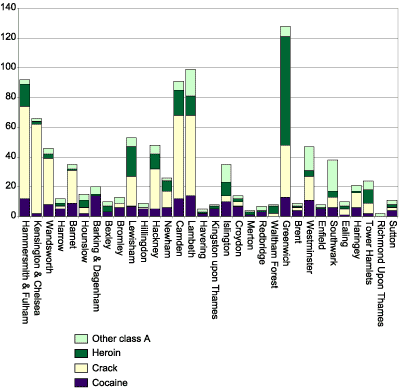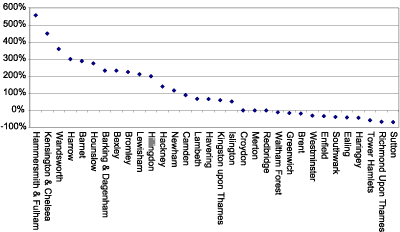Contents
Report 9 of the 11 Oct 01 meeting of the Professional Standards and Performance Monitoring Committee and provides an update on MPS activities under the umbrella of Operation Crackdown since 1 April 2001.
Warning: This is archived material and may be out of date. The Metropolitan Police Authority has been replaced by the Mayor's Office for Policing and Crime (MOPC).
See the MOPC website for further information.
Operation Crackdown (update)
Report: 9
Date: 11 October 2001
By: Commissioner
Summary
This report provides an update on MPS activities under the umbrella of Operation Crackdown since 1 April 2001.
A. Recommendations
Members are asked to note the contents of this report.
B. Supporting information
1. This operation is designed to reduce drug-related crime by prioritised and co-ordinated enforcement and intelligence gathering activity. This involves all London boroughs who collectively will deliver the MPS target of a 10% increase, against 2000 / 2001, in judicial disposals for supply and possession with intent to supply offences of class ‘A’ drugs. The MPS is on target to achieve this. An ‘activity phase’ took place between 25 June - 22 July 2001, with another due to start on 17 September 2001.
2. For 2001/2002 targets have been set to increase the number of Judicial Disposals (JDs) for supply and possession with intent to supply (PWITS) class ‘A’ drugs by 10% against the previous year’s figure. In real figures this makes the target 2220 JDs to be achieved by 31 March 2002.
3. As at 10 September 2001 the MPS-wide number of JDs achieved in the relevant categories amounted to 1052 or 47.4% of the total after 45% of the counting period had elapsed. Direct comparison between the end of July figures in 2000 and 2001 shows 599 and 757 JDs achieved respectively.
4. In brief, since 1 April 2001 some 19 operations have been authorised targeting street dealers, over 440 raids were carried out and 44% of the £1.5m budget has been spent or allocated.
5. The following charts given at Appendices 1 and 2 show the monthly variation in Class ‘A’ JDs for supply and PWI to supply between 2000/2001 and 2001/2002 levels. This shows marked increases during the two MPS-wide Crackdown activity phases of February 2001 and July 2001.
6. Territorial Policing has supported and funded extra training for officers on borough. This training teaches officers how to enter premises more quickly and safely. This increases the chances of officers finding evidence and seizing drugs.
7. The Crackdown ‘Gold’ group has been instrumental at a strategic level in the identification of those who ply their trade cross borough or supply to street dealers.
8. The Crackdown support team has visited the majority of boroughs for ‘face to face’ advice, support and spreading of best practice. During 11 of these visits questionnaires were completed which seem to indicate a rise in the morale of officers engaged in the operations on borough.
9. During the June - July phase the following activity occurred,
- 430 raids.
- 19 pro-active operations that targeted street drug dealers across the MPS.
- Crackdown featured on the Bill TV series (helping give the operation high profile publicity).
- During a raid in Sutton a rap song was found which contained the lyrics of ‘Not getting caught by Crackdown’.
- 76% of boroughs have dedicated Crackdown drug co-ordination/liaison staff.
- Raid activity exhausted TSG, PSD and CO54 resources on seven occasions.
- In Wandsworth a covert operation on an estate led to 14 arrests, a firearm was recovered; six vehicles and £2128 seized. The officers were thanked by residents on the estate and they showed officers where dealers hid their drugs. Just prior to the arrest the dealers dumped 25 rocks of cocaine.
- In Sutton, following a raid on a crackhouse, 25 rocks of cocaine were found. One of the three occupants jumped out of a window, falling 3 floors to the ground. He suffered fractures. This man said he had been pushed by one of the female officers. He later withdrew this allegation and said that he jumped because he wanted to escape and was paranoid about police. One of the suspects is of interest to Trident, Immigration and NCIS. This case is not yet complete.
- In Barking and Dagenham a dealer who operated from a pub was arrested and charged with drug dealing. Within 4 weeks of his arrest he had pleaded guilty at Crown Court and sentenced to 4 years imprisonment.
- Lambeth has performed well against its drug target and one pro-active operation led to 13 dealers being arrested. The total number of judicial disposals achieved by Lambeth is the second highest in the MPS. Greenwich has the most judicial disposals.
- A covert operation in Barnet led to the arrest of 19 dealers. A street dealer slashed an officer with a knife during part of the initiative. The local community welcomed this operation and open street drug dealing at the open public square on the estate no longer takes place on this estate.
- Forensic intelligence linked one target dealing drugs in Peckham and Hammersmith.
- A submission to the scientific laboratory of class ‘A ‘ drugs during the last activity phase averaged 64 per week. Submissions rose by approximately 60% during February and July. During this phase Lambeth and Camden submitted the most drugs exhibits to the Forensic Science Service and almost twice as many as the next most prolific borough, Kensington and Chelsea.
Arrest referral monitoring
10. The routine statistics from the London Arrest Referral Monitoring Database (LARMD) for April 2001 - July 2001 are produced below. The arrest referral database has a rolling total. The arrest referral workers (ARWs) collect data when they interview an arrested person and there is no set time limit on when this data should be forwarded to the database, therefore some agencies take longer than others. If information on the monitoring form cannot be scanned onto the database then the form is returned to the ARW to be corrected. The process can on occasions take several months.
| Date | Contact | Assessed | Referred | Total | |||
|---|---|---|---|---|---|---|---|
| April 2001 | 778 | 65.8% | 189 | 16.0% | 216 | 18.3% | 1183 |
| May 2001 | 1043 | 68.8% | 230 | 15.2% | 243 | 16.0% | 1516 |
| June 2001 | 1162 | 71.0% | 203 | 12.4% | 272 | 16.6% | 1637 |
| July 2001 | 784 | 68.9% | 116 | 10.2% | 238 | 20.9% | 1138 |
Key Local Authority performance for June 2001
| Local Authority | Contact | Assessed | Referred | Total | ||||
|---|---|---|---|---|---|---|---|---|
| Brent | 114 | 91.2% | 5 | 4.0% | 6 | 4.8% | 125 | 7.6% |
| Camden | 152 | 96.8% | 0 | 0% | 5 | 3.2% | 157 | 9.6% |
| Greenwich | 2 | 15.4% | 0 | 0% | 11 | 84.6% | 13 | 0.8% |
| Hackney | 109 | 85.2% | 8 | 6.3% | 11 | 8.6% | 128 | 7.8% |
| Islington | 91 | 98.9% | 1 | 1.1% | 0 | 0.0% | 92 | 5.6% |
| Lambeth | 10 | 17.2% | 10 | 17.2% | 38 | 65.5% | 58 | 3.5% |
| Lewisham | 41 | 61.2% | 7 | 10.4% | 19 | 28.4% | 67 | 4.1% |
| Southwark | 13 | 32.5% | 4 | 10.0% | 23 | 57.5% | 12 | 0.7% |
| Tower Hamlets | 12 | 27.9% | 16 | 37.2% | 15 | 34.9% | 43 | 2.6% |
| Westminster | 190 | 81.9% | 16 | 6.9% | 26 | 11.2% | 232 | 14.2% |
Key Local Authority performance for July 2001
| Local Authority | Contact | Assessed | Referred | Total | ||||
|---|---|---|---|---|---|---|---|---|
| Brent | 86 | 86.9% | 3 | 3.0% | 10 | 10.1% | 99 | 8.7% |
| Camden | 35 | 83.3% | 1 | 2.4% | 6 | 14.3% | 42 | 3.7% |
| Greenwich | Information not available | |||||||
| Hackney | Information not available | |||||||
| Islington | Information not available | |||||||
| Lambeth | 8 | 21.6% | 6 | 16.2% | 23 | 62.2% | 37 | 3.3% |
| Lewisham | 33 | 51.6% | 4 | 6.3% | 27 | 42.2% | 64 | 5.6% |
| Southwark | 1 | 5.3% | 0 | 0.0% | 18 | 94.7% | 19 | 1.7% |
| Tower Hamlets | 21 | 47.7% | 11 | 25.0% | 12 | 27.3% | 44 | 3.9% |
| Westminster | 183 | 82.8% | 7 | 3.2% | 31 | 14.0% | 221 | 19.4% |
11. It is difficult to assess the impact of Operation Crackdown on drug referral at this stage for two reasons. Firstly, the data for July was incomplete at the time of preparing this report. Secondly, because the data is produced on a monthly basis and the operation spanned the months of June and July it was not possible to extract the data and make a direct comparison with the preceding months. Consultation will take place to establish if a system can be implemented to extract more precise information to enable more effective analysis of the effect of future Crackdown operations on drug referral. The independent evaluation being undertaken by Southbank University, supported by the Imperial College School of Medicine and the National Addiction Centre is not yet complete.
12. The tables illustrate a wide variation of contact/referral within boroughs. Lambeth and Westminster make perhaps the most interesting comparison. The total for Westminster for June and July was 453. Of these 57 were referred for treatment. The total for Lambeth was 95 with 61 being referred for treatment. The comparative referral percentages being 12.5% for Westminster and 64% for Lambeth. The MPS target of 3000 referrals is achievable.
13. In conclusion, the MPS continues to target street dealers of class ‘A’ drugs. As suggested in the report by Southbank University sustained local activity has been maintained. This leads to improved perceptions of safety for local residents in targeted areas. This very real reduction in fear for these people is considerable and helps to restore local confidence in police. The morale of officers is enhanced as they witness pro-active enforcement against known drug dealers.
C. Financial implications
The budget is £1.5 million from the Home Office, 49% of the budget has been allocated and as of September 2001 we will have completed 50% of the financial year. The predicted spend is therefore on budget.
D. Background papers
None
E. Contact details
Report author: DCI Geoffrey Woolgar 020 7230 2083
For information contact:
MPA general: 020 7202 0202
Media enquiries: 020 7202 0217/18
Appendix 2: Numbers of JDs for supply and PWI class A drugs, Apr-Aug 2001

Send an e-mail linking to this page
Feedback
